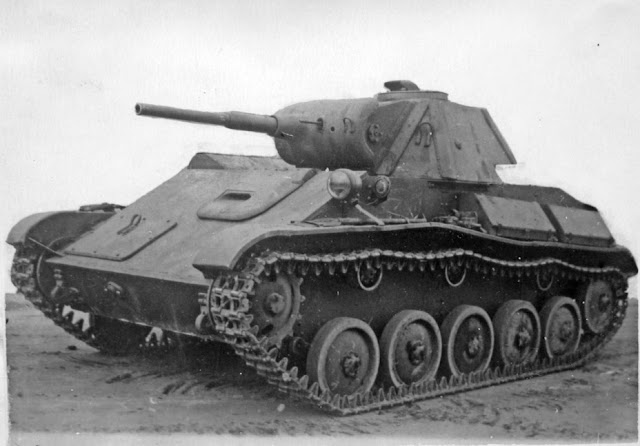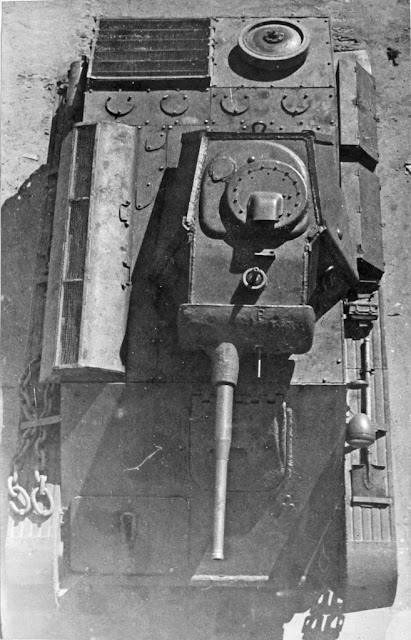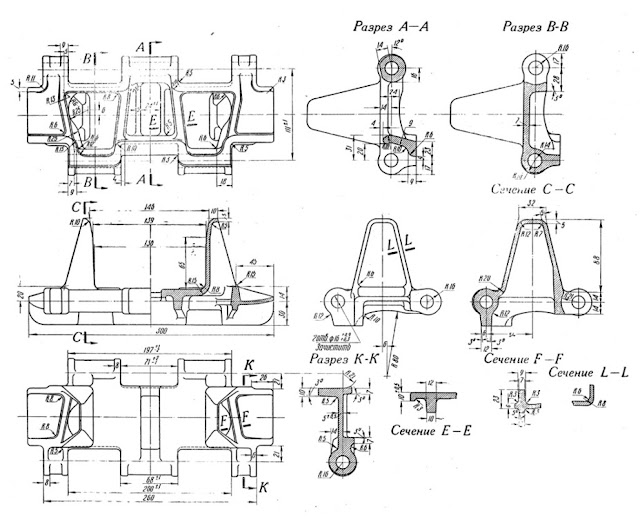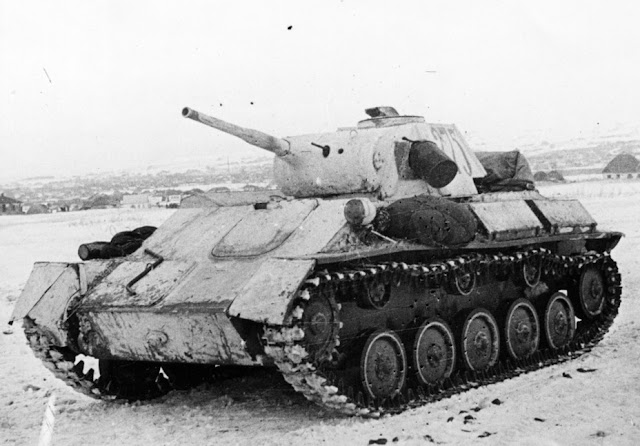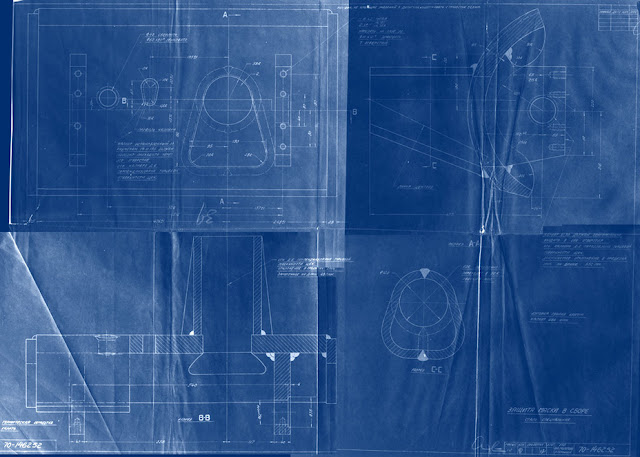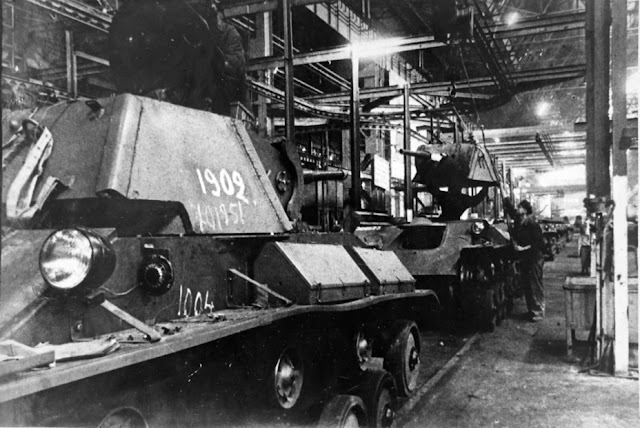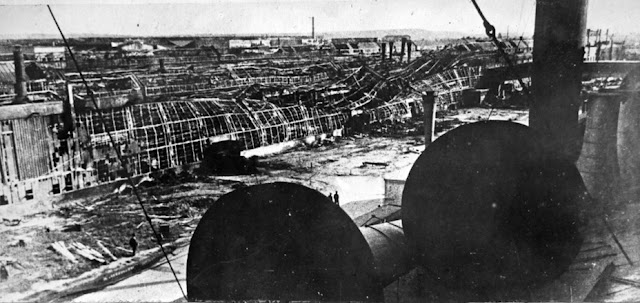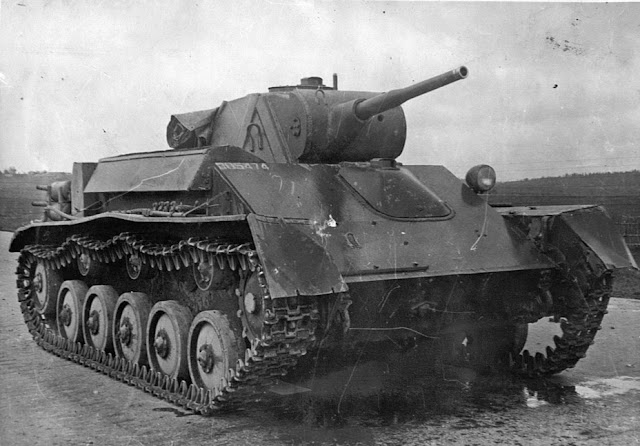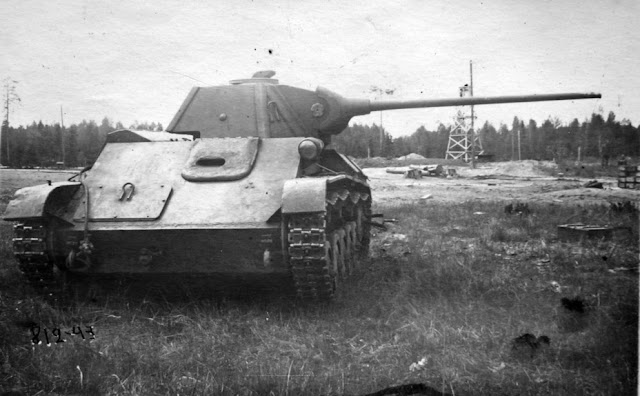GKO decree #1394 "On production of T-70 tanks at the Molotov Gorkiy Automotive Factory" was signed on March 6th, 1942. Work on improvement of the T-60's armament resulted in a completely new tank that used many of its predecessor's components, but was superior to it in every respect. Of course, it was not a perfect replacement for the T-50, which fell victim to production issues. Nevertheless, it was suitable for the role of a light tank. The T-70 became the second most produced light tank, after the American Light Tank M3 family. This article tells the story of the T-70B, the modernized version of the light tank.
T-70 B-side
Even decree #1394 hinted that the T-70 needs some improvements. The second section of the decree tasked GAZ with correcting defects that were uncovered during trials. According to the third section, the T-70 would be produced with wider tracks and thicker road wheels starting with June 1st, 1942. The need to modernize the tank was caused by increased pressure on the suspension. While the T-60 with thickened armour put 775 kg on one road wheel, this figure increased to 920 kg on the T-70.
T-70 tanks produced at GAZ before August of 1942 looked like this.
However, this increase had almost no effect when the tank was driving on paved or dirt roads. Therefore, putting the T-70 into production with T-60 tracks and road wheels seemed feasible. However, driving on snow and swampy terrain was a different story. Complains about the T-60's poor performance on snow started coming in during the winter of 1941-42. The increased mass of the T-70 didn't help matters.
The T-70 also did not perform great on soft soil. During trials in the summer of 1942, a production tank was driven across a swamp where foreign tanks were being tested prior. The results weren't encouraging. The tank made it 70 meters out of 80, but bottomed out and bogged down. It was only able to get out using an unditching log. The Light Tank M3, Pz38(t), and Valentine VII managed to cross this section of swamp successfully.
The same vehicle from the right. Note the exhaust pipes leading across the right side. Starting on August 5th, 1942, they were moved to the engine deck.
The deadlines specified in GKO decree #1394 were not met. It proved difficult to put the T-70 into production. Initially, defects discovered during trials of the prototype and pilot batch had to be resolved. This process was not complete by May. 5 changes to the cooling system and gun mount were introduced in April of 1942, and 9 more changes were introduced in May.
Early T-70s were not equipped with radios or internal communication devices. The installation of PTUs only began on May 25th, and a portion of the tanks was equipped with 9-R radios starting on June 4th. On May 12th the electric equipment was changed from a 6 V to a 12 V circuit, and two signal lamps for the driver were added on the 19th. Serious changes were made to the cooling system, which drastically increased its effectiveness. Improvements were made in June: the first signs of an engine bulkhead appear, plus the turret was changed. The GT-500 generator was used starting in July, and a dust deflector was added to the air cleaner of the rear engine.
Early type tank, seen from above.
Another important factor that affected the course of the T-70's modernization was issues with supplies of components. For instance, issues with gearboxes were experienced in June, and complaints were made about the speed and quality of engine production as well. The biggest problems were had with the hull and turret. Factory #180 in Saratov "excelled" in this, earning as many complaints during the course of T-70 production as with the T-60. As a result, instead of 390 planned tanks in June, only 350 were delivered. Factory #38 was having similar problems, delivering only 117 tanks out of 130. The limiting factor here was the supply of hulls.
July was better from an assembly standpoint. GAZ produced all 450 tanks that were ordered, 101 of which had radios. Factory #38 managed to surpass quota, completing 153 tanks out of 150.
Trials showed that the T-60 and T-70 perform worse in swamps than foreign light tanks.
Work on modernizing the T-70's suspension began at the GAZ design bureau in July of 1942. A new 300 mm wide track link was completed by the 12th. It can be visually distinguished by a lack of round openings. At the same time, reports that came from the Bryansk and Central Fronts inidicated that 15 mm of side armour was not enough for this tank.
In addition, the complaint that the commander of the light tank was overloaded with tasks was first raised. He had to combine the duties of the commander, gunner, loader, and radio operator. This was the trigger for the development of a two-man turret, which eventually resulted in the creation of the T-80, the last Soviet wartime light tank. Information about Astrov having plans for a two-man turret for the T-70 are fantasy.
Another famous fantasy, which appeared back in the 60s, was the name of the tank with modernized running gear. The widely used index T-70M came from one not particularly well researched reference book composed after the war. We can also thank this book for inventing the index "T-40S". As for the real name of the modernized T-70, it appeared in July of 1942, and was different: T-70B. The index T-70-B was also used in correspondence.
T-70B track link, designed in July of 1942. Other reinforced running gear elements were also designed then.
The development of new tracks coincided with complaints about the old tracks. Reports about track links bending when the tank hit hard objects began coming in. There were complaints about other running gear elements. The drive sprockets bent, and the torsion bars sagged by 6-8 cm. This was especially true for the rear of the tank.
6 T-70 tanks were put through trials on June 24th. Two of them were mass production types, the others had a reinforced running gear. Two had 25 mm thick sides, and two more had 35 mm thick sides. The tanks with 25 mm of side armour weighed 10,400 kg, and the ones with 35 mm weighed 11 tons. Two tanks had altered exhaust pipes, which were introduced for production T-70s starting with August 5th, 1942. Two more tanks received engine bulkheads which were introduced into production on August 8th. Different types of mudguards and fenders were also used. As a result, all 6 tanks had a distinct look.
Exhaust pipes going over the roof of the engine compartment were introduced on August 5th, 1942.
Trials showed that the stock running gear only performed reliably for 300 km. After that, the road wheels started breaking, torsion bars sagging, and track links cracking. The reinforced track links tested on the second tank were also rejected due to the eyes breaking. As for the reinforced suspension, it worked reliably. However, the tank's speed fell by 5% due to the increased mass. The result was Solomon's solution: this running gear would be put into production for tanks with 15 mm of side armour on September 10th. It was planned for the side armour to be increased to 25 mm on October 1st, but that never happened.
Double air cleaners were also introduced, which raised the lifespan of the engines from 640 to 1200 km. They were added to tanks on September 5th, on the same day that a reinforced main linkage was added. Another addition was the driver's hatch with an observation device. It was designed in July of 1942, tested on one of the tanks with thicker side armour, and introduced into production on September 16th.
A new driver's hatch with an improved periscopic observation device. Its introduction noticeably improved the driver's visibility. This hatch was designed in July and introduced into production starting with September 16th, 1942.
The first two T-70Bs were delivered by GAZ in late September. Officially the new running gear was in production starting with September 1st, along with an improved ammunition rack. The latter allowed the tank to carry 90 rounds of ammunition for the 45 mm gun. New fenders were introduced later, on October 10th. In parallel, T-70B production was organized at factory #38. At that point, both factories produced identical tanks. The only difference was the serial number system. According to an order from the People's Commissar of Tank Production #676ss issued on September 14th, 1942, vehicles produced at factory #38 had their serial numbers prefixed with the letter L. This order also got rid of the different serial number systems used at different factories.
T-70B tanks produced from October 1942 to early 1943 looked like this.
Both factories produced tanks like this until the end of 1942. In early 1943, GAZ remained the only factory that produced T-70 tanks. GKO decree #2559 "On organization of SPGs at the Uralmash factory and factory #38" ordered the production of SU-12 SPGs rather than T-70B tanks in Kirov. Factory #40, created via reorganization of factory #592, became the secondary light tank production center. However, there was a nuance: instead of the T-70, the factory would build T-80 tanks. GAZ would also transfer over to T-80 production at some point later, but T-80 production never took hold. In total, GAZ delivered 3495 T-70 tanks in 1942, of them 2252 regular and 1243 with radios. As for factory #38, it reported delivery of 1378 tanks.
Stamped and welded gun mantlet. It was developed in July, but introduced into production in the end of 1942.
Due to the need to quickly put the T-80 into production, the T-70 did not change too much in early 1943. The biggest change was the gun mantlet. It was designed in July of 1942, but for various reasons it was not implemented until December of 1942. There were significant issues with producing even the current model. GAZ systematically fell short of quota starting with October of 1942. In November, only 320 T-70B tanks were delivered instead of 650. Only 510 were delivered in December instead of 700. This was partially due to the modernized suspension, but there were other problems. The biggest one was issues with casting, especially of engine blocks and track links. In December, 75.5% of cast engine blocks were rejected. This was the main limiting factor.
One of the first T-70B tanks with a new gun mantlet. December 1942.
The same issues migrated to 1943. 300 tanks were delivered in January instead of 550, and 130 tanks without track links remained into February. The factory managed to complete February's quota of 400 tanks through enormous effort, and 60 tanks were left without tracks by the start of March. The March quota of 500 tanks was met, but only 500 tanks were delivered in April out of 550. The factory actually built just 440 tanks, the rest were the same 60 T-70Bs without tracks. Realistically, the customer accepted only 275 tanks, and 225 remained at the factory and had to be fixed. This is when GAZ declined to produce the T-80. In May, only 325 T-70s were delivered instead of 450.
Production of the T-70B, Molotov GAZ, spring 1943.
It would be wrong to say that Gorky did not perform any modernization of the T-70. On March 29th, 1943, GKO decree #3092 demanded that the quality of the factory's output must increase. As a result, work on improvements was expedited. A new oil filter was added on April 20th, and K-43 carburettors were introduced at the same time. The exhaust system was changed starting on April 18th to prevent burns to infantry riders. The idler carrier changed on April 10th. 37 changes were made in total in April-May of 1943. All of these changes resulted in a significant increase in quality. However, there were still issues with subcontractors, particularly with ZIS-5 gearboxes produced in Miass.
Factory after German bombings, mid-June 1943.
German aircraft caused even more issues for the factory. The factory was bombed heavily from June 5th to June 14th. Many plants were destroyed. Heroic effort revived the factory in a short amount of time. Assembly of tanks and other products continued without a roof over the workers' heads. The buildings were repaired in parallel. In total, 128 tanks were delivered in June.
T-70B tank, June 1943 production. The stamped driver's hatch can be seen. The cast hatch was still in use alongside it.
The quality of tanks produced in Gorky deserves a separate mention. However, recall the times that T-70B tanks were built. Quality issues were common with any Soviet armoured vehicle of this time. This was the cost for rapid increase in production volume to several times that of peacetime production.
Everything is relative. When reliability trials with KV-1S and T-34 tanks from various factories, as well as the T-70B, it was Gorky's tank that was deemed the most reliable. A February production tank drove for 1223 km between April 14th and May 20th. The T-70B was the only tank that could confidently continue service after the trials. Further trials of other tanks were senseless.
The same T-70B from the left. The tank looked like this until the end of October 1943.
German bombings seriously affected the output of the factory. The production quota was drastically lowered. 250 vehicles were expected in July. The factory managed to surpass this quota, delivering 260 tanks. The tank changed its look slightly around this time. This is caused by actions from the hull manufacturer. A stamped driver's hatch was proposed in the summer of 1942. It wasn't introduced then, but an altered design went into production in 1943 at factory #176 in Murom. This was factory #40's manufacturer of T-80 hulls and turrets. Since hatches on the T-70 and T-80 were compatible, these hatches were also sent to GAZ, where they were installed on May production tanks. The cast hatch also remained in production, and was used on both the T-70B and SU-12.
Some tanks were built with a radio antenna port in the rear of the turret. It's possible that this is connected with the 12-RT radio, which was used on T-70B tanks starting with July of 1943. There were also plans for infantry handrails on the turret, but it's not known whether these plans were ever implemented.
This angle shows the exhaust pipe guard introduced on April 18th.
Rapidly obsolete
The appearance of the T-70B on the front lines in late 1942 was met with mixed feelings. The reliability of the running gear increased drastically, but another issue took its place. The running gear of the T-70 and T-70B was drastically different. The road wheels and return rollers were 130 mm wide, and the torsion bars and suspension arms were different too. This was unlikely to thrill unit mechanics. There was another, more serious issue. In mid-1942 the Germans stopped producing light tanks and switched to SPGs. The cause was simple: light tanks were no longer suited for modern war. The PzII and Pz38(t) could do little against the T-34 and KV-1. The same could be said for the T-70B when it was compared to German medium and heavy tanks.
T-70 with the VT-42 gun, May 1943.
The combat effectiveness of the T-70 was higher than that of its predecessor, the T-60 small tank. However, its enemies changed too. This wasn't so obvious during the fighting at Stalingrad in late 1942, but in February-March of 1943, during fighting at Kharkov, the situation changed. The GABTU felt that light tanks were becoming obsolete even earlier. The issue of developing a tank gun with the ballistics of the 45 mm anti-tank gun designed by OKB-172 was raised in May of 1942. This gun was adopted under the index M-42. The increased barrel length allowed the gun to defeat tanks that were too tough for the standard 45 mm gun.
The gun passed trials, but it was too late.
After some delay, the design bureau of factory #235 (Votkinsk) began working on a long barrelled tank gun. Like OKB-172, it was subordinate to the NKVD. The development there was also largely done by prisoners. The new tank gun was indexed VT-42. The trials program was signed on November 23rd, 1942, but the gun and its T-70 tank arrived at the ANIOP on May 12th, 1943. Trials continued until June 1st. The gun passed trials. However, by June 1st it was already too late. In addition, the GAU and NKV already had an alternative: a subcaliber round that could penetrate the side of a Tiger tank from 200 meters.
The T-70 was insufficiently effective by the summer of 1943. This was true for all light tanks of the era.
The T-60 was largely pushed out of the armed forces by the T-70 and T-70B by the summer of 1943. However, the T-70 itself was obsolete. Fighting at Kursk showed that the time of light tanks is going away. Units with T-70 tanks took heavy losses. Analysis of the situation forced the Red Army to abandon light tanks in their current state. This did not mean that there would be no more light tanks, but developing the T-60/T-70 family any further was pointless. Instead, a new generation light tank would be designed. Its characteristics would be like the T-50, but it would have a 76 mm gun. The long process of designing a prospective light tank began, which eventually ended with nothing. As for factories building light tanks, they switched to producing the SU-76M. The USSR did the same thing that Germany did. The only country producing light tanks at that point was the USA.
T-70B as a commander's tank in a SU-76M regiment. Note that the antenna port is in the rear of the turret.
The removal of the T-70B from production did not mean that the tanks would vanish. They continued to serve in the Red Army in their primary role. Of course, their numbers declined as they were replaced with T-34s. The T-70B was often used as a commander's tank in SPG regiments. Many T-70s fought on the Leningrad Front until the fall of 1944. Even on more central fronts, the T-70 continued to fight into the summer of 1944, specifically in tank regiments used in cavalry divisions. In these units the T-70B was actively used, for example, in the Lvov-Sandomierz offensive. Vehicles of this type were used by the 61st and 87th Independent Tank Regiments.
T-70B on parade in Kiev. November 7th, 1945.
Overall, the T-70B was a decent tank. Many issues that plagued it were caused by the speed at which it was developed and put into production. The tank's short career was caused by the rapidly changing state of the front lines. Tank development was so rapid that there was no room for the light tank on the battlefield soon after it was designed.
Nevertheless, the T-70B was not built in vain. Its chassis was useful when designing many vehicles. The most popular were the SU-12 and SU-15M, but the T-70B chassis was also used to build Ya-11, Ya-12, Ya-13, and M-2 tractors. Even the post-war K-61 prime mover is a descendant of this light tank that appeared in a very difficult time.
